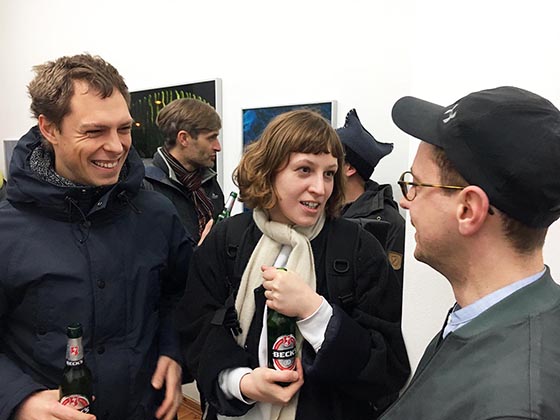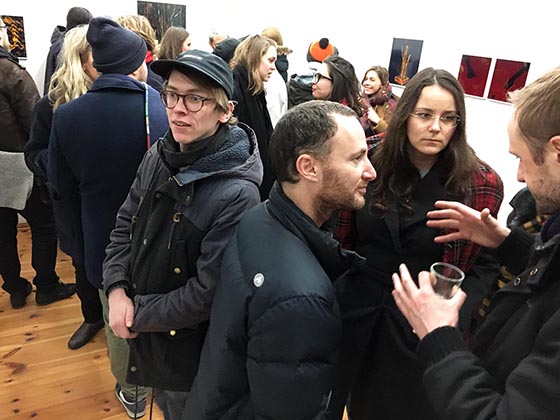Alexander Gehring
The Alchemy of Colour

Hand, 60 x 60 cm, analoger C-print, Lasurfarbe, gerahmt, Auflage 4+1, 790 €
Alexander Gehring untersucht in seiner zweiten Einzelausstellung bei pavlov’s dog das Verhältnis von Fotografie und Alchemie. Inwieweit wirken sie noch heute ? Alchemisten versuchten stets die Natur und die in ihr innewohnenden Prozesse zu verstehen und mit dem gewonnenen Wissen in diese Abläufe einzugreifen. Dazu gehört die Idee Elemente umzuwandeln. Das beschränkte sich nicht nur auf den Versuch Gold herzustellen, begründete aber den bis heute gültigen Ruf einer Geheimwissenschaft.
Auch bei den Abläufen der analogen Fotografie gibt es geheimnisvolle Momente. Aus einem unsichtbaren Bild (das latente Bild) wird etwas Sichtbares – ein Abbild der Natur, der Welt. Im Fotolabor werden die Analogien zwischen Alchemie und Fotografie erlebbar. So bezeichnen viele Menschen, die zum ersten Mal den Entwicklungsprozess eines Papierbildes in der Entwicklerschale bestaunen, diesen Moment als „magisch“. Hier wie da werden durch den Einsatz von Chemikalien, Metallen und Salzen chemische Reaktionen in Gang gesetzt, die die Umwandlung von unsichtbar zu sichtbar hervorrufen und etwas Neues schaffen. Das Herzstück eines jeden Fotolabors ist die Dunkelkammer: Ein geheimnisvoller Raum, nur für Eingeweihte bestimmt, die die Gesetze und Regeln des Ortes kennen und befolgen – nichts anderes als ein Tempel einer Geheimgesellschaft.
Alexander Gehrings Ansatz ist spielerisch und hinterfragt die analoge Fotografie. Die Motive bleiben rätselhaft und bedienen sich einer alchemistischen Symbolik: die Elemente der Natur, ihre Farben und Aggregatzustände. Die oft verwendete Farbe Rot schlägt eine Brücke. Das rote Licht der Dunkelkammer ist zugleich ein Wahrzeichen der Alchemisten. Rot war in der Alchemie die Farbe der Farben. Dies geht unter anderem auf Rubinglas zurück, das bei alchemistische Experimenten entdeckt wurde. Es wird bis heute geschätzt – genau wie die analoge Fotografie.
Michael Biedowicz
Der in Berlin lebende Künstler Alexander Gehring (* 1981 in Bielefeld) studierte Fotografie und neue Medien an der Fachhochschule Bielefeld sowie am London College of Communication. Seine Arbeiten wurden unter anderem in der Aperture Gallery in New York, im Museum Morsbroich, der Warte für Kunst in Kassel, der Galerie Tagomago Paris sowie im Camera Club New York ausgestellt. 2016 gewann er den Merck Preis der Darmstädter Tage der Fotografie.
Ausstellung 16.3. 2018 – 21.4.2018
* * * * * * * * * * * * * * * * * * * * * * * * * * * * * * * * * * * * * * * * * * * * * * * * * * * * * * * * * * * * * * * * * * * * * * * * * * * * *
to be announced
Alexander Gehring
The Alchemy of Colour

Turm, 105 x 103 cm, analoger C-print, gerahmt, Auflage 4+1, 1600 €
In his second solo exhibition at pavlov’s dog Alexander Gehring explores the relationship between photography and alchemy. To what extent are they still effective today? Alchemists constantly tried to understand nature and its immanent processes and to use the acquired knowledge to intervene in those procedures. The idea to transmute elements is part of it. That wasn’t limited to attempting to create gold, but established the reputation as an occult science, as it still is today.
There are mysterious moments in the processes of analogue photography, too.
Something visible originates from an invisible image (the latent image) – a reflection of nature and the world. The analogies of alchemy and photography can be experienced in the photo lab. Thus, many people, who marvel at the development of an image on paper in the developing tray for the first time, describe that moment as „magical“. In both cases the use of chemicals, metals and salts starts chemical reactions, that provoke the conversion from invisible to visible and create something new. The darkroom is the core of each photo lab: a mystical space, for insiders only, who know and follow the laws and rules of the space – nothing else than a temple of a secret society.
Alexander Gehring’s approach is playful and questions analogue photography.
His subjects stay enigmatic and use alchemistic imagery: the elements of nature, their colors and physical states. The frequently used color of red builds a bridge. The red light of the darkroom is also a symbol of the alchemists. Red was the color of colors in alchemy. Amongst others this can be traced back to ruby glass, that was discovered in alchemist experiments. It is still valued today – just as analogue photography.
Michael Biedowicz
Berlin-based artist Alexander Gehring (*1981, Bielefeld) studied photography and new media at Bielefeld University of Applied Sciences and London College of Communication. His work has been exhibited at Aperture Gallery in New York, Museum Morsbroich, Warte für Kunst in Kassel, Galeria Tagomago in Paris and The Camera Club of New York amongs others. He was the recipient of the Merck Award of Darmstädter Tage der Fotografie in 2016.
Exhibition 16.3. 2018 – 21.4.2018
* * * * * * * * * * * * * * * * * * * * * * * * * * * * * * * * * * * * * * * * * * * * * * * * * * * * * * * * * * * * * * * * * * * * * * * * * * * * *


